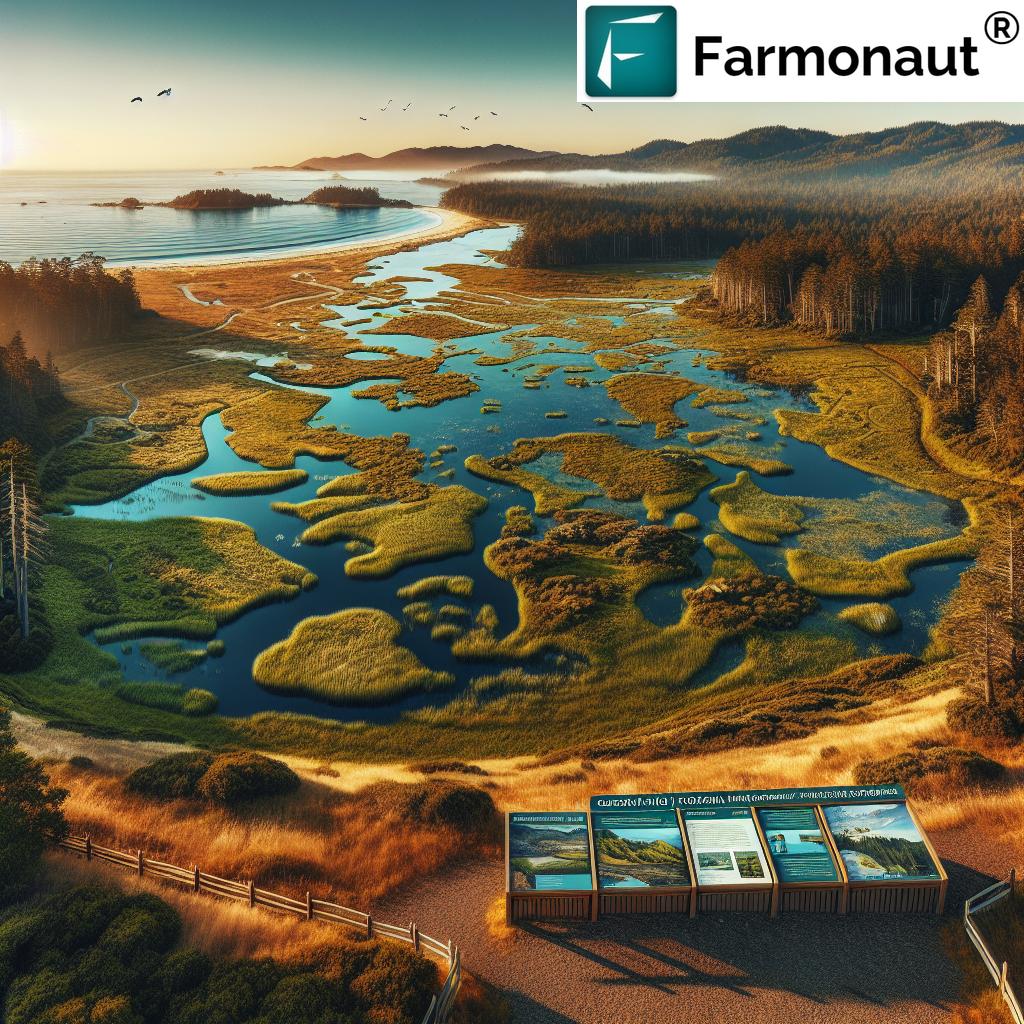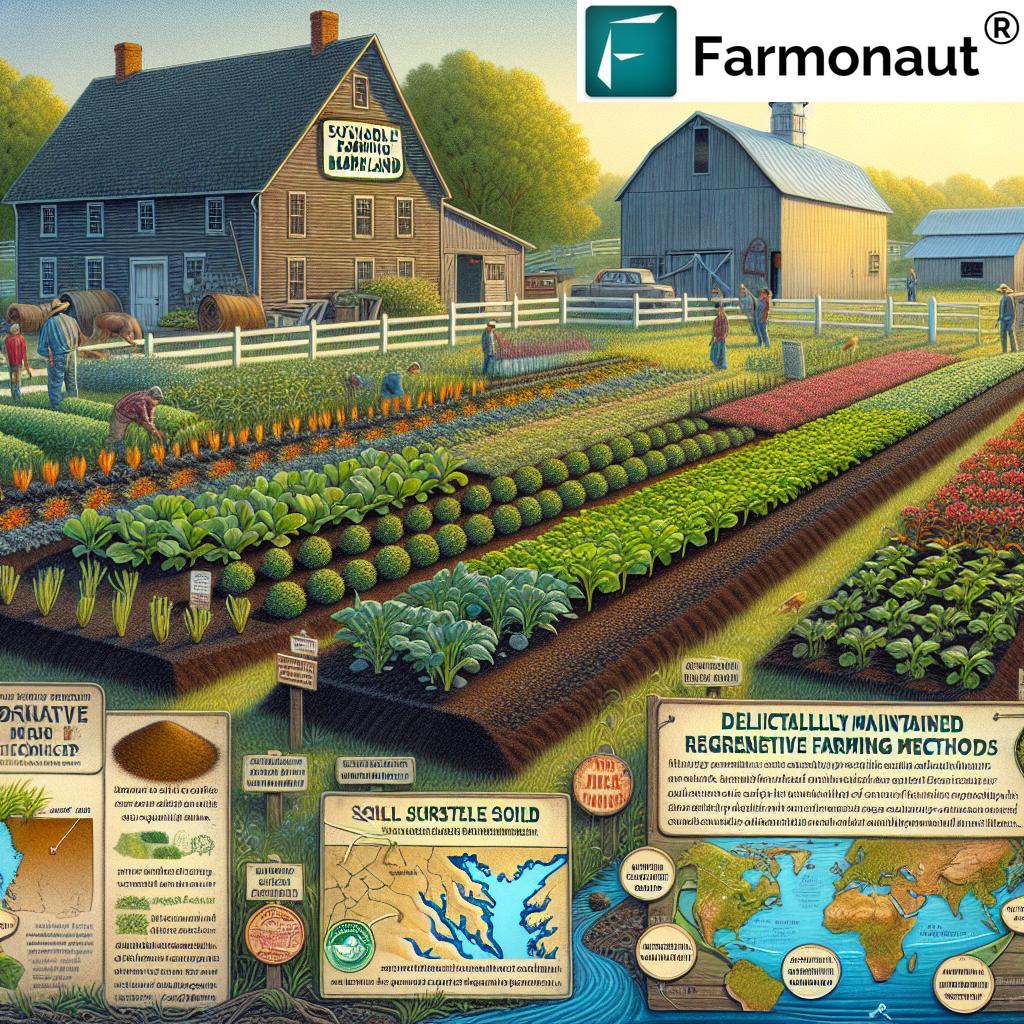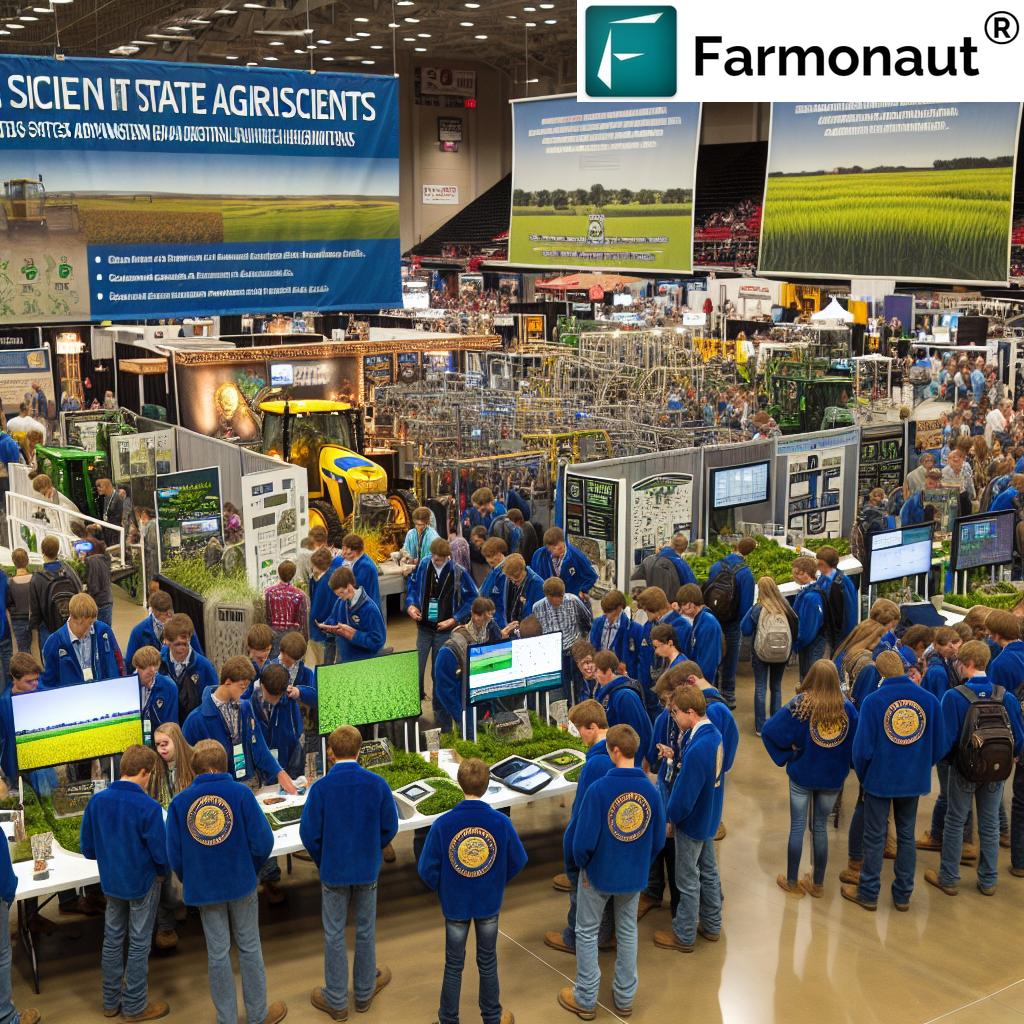Maryland Natural Resources Laws: 7 Powerful Changes for Conservation
Table of Contents
- Introduction: Maryland’s Commitment to Natural Resource Conservation
- Maryland Trivia: Chesapeake Bay Conservation Funding Boost
- Overview: Why Maryland Natural Resources Laws Matter in 2024
- Summary Table of 2024 Maryland Natural Resources Law Changes
- 1. The Chesapeake Bay Legacy Act: Boosting Conservation & Agriculture
- 2. Public Lands Management Maryland: The New Public Lands Bill
- 3. Expanding Regenerative Agriculture Maryland: Supporting Sustainable Farming
- 4. Advancements in Fishery Management & Aquaculture
- 5. New Pathways for Land Acquisition & Stewardship
- 6. Operational Efficiency for Open Space Program (Stateside & Local)
- 7. Enabling Nonprofit Fundraising & Public-Private Partnerships
- Harnessing Technology for Conservation: The Farmonaut Advantage
- Farmonaut Apps & Platform Links
- FAQs: Maryland Natural Resources and Conservation Laws
- Conclusion
“Maryland’s 2024 laws increased Chesapeake Bay conservation funding by 30%, directly supporting water quality and wildlife habitats.”
Introduction: Maryland’s Commitment to Natural Resource Conservation
As Marylanders, we are stewards of a state rich in natural beauty, from the rolling Appalachian mountains to the shores of the Chesapeake Bay. In 2024, our commitment to protecting these diverse natural resources has never been stronger. The Maryland General Assembly in Annapolis, MD, concluded a landmark legislative session that produced critical new natural resources laws. These laws will shape the future of public lands management Maryland, our farms, parks, forests, and the treasured Chesapeake Bay.
In this comprehensive breakdown, we highlight the 7 most powerful changes in Maryland’s approach to conservation, sustainable agriculture, and public land stewardship. If you care about improving ecological, social, and economic outcomes—for our communities, farmers, and natural landscapes—then these legislative updates are of immense importance.
Overview: Why Maryland Natural Resources Laws Matter in 2024
Change is at the heart of progress. The Maryland Department of Natural Resources (DNR), alongside passionate legislators, nonprofit partners, and environmental advocates, worked tirelessly during the recent assembly to pass forward-thinking bills. The two keystone pieces—the Chesapeake Bay Legacy Act and the Public Lands Bill—were both approved and signed, with additional amendments and funding mechanisms set to reshape how we manage our land, water, forests, and agricultural economy.
Here’s what makes these laws so pivotal:
- They enable sustainable farming practices and support regenerative agriculture Maryland on both private and public lands.
- They enhance conservation and public land stewardship in state parks, forests, and protected areas.
- They advance Chesapeake Bay conservation efforts by reducing nutrient runoff in Maryland, benefiting wildlife, water, and coastal communities.
- They provide operational flexibility and new funding pathways for state-managed open space initiatives.
- They streamline processes for commercial seafood harvesters and aquaculture, boosting local economic opportunities from the Bay’s bounty.
- They reinforce Maryland’s role as a national leader in sustainable agriculture, land management, and environmental protection.
Summary Table of 2024 Maryland Natural Resources Law Changes
| Law/Amendment Title | Purpose | Estimated Impact Area | Key Sustainability Benefit | Implementation Timeline |
|---|---|---|---|---|
| Chesapeake Bay Legacy Act | Enhance Bay conservation, support regenerative farming, streamline aquatic policies | Bay watershed (approx. 20,000 acres) | Boosted Chesapeake Bay conservation, reduced nutrient runoff | July 2024 (scheduled effect) |
| Public Lands Bill | Tie state land purchase with management jobs, enable nonprofit fundraising | Over 50,000 acres of forests, parks, MAs | Improved public lands management, job creation | October 2024 (effective date) |
| LEEF Program (Leaders in Environmentally Engaged Farming) | Score farms on conservation & economic practices | All MD farmland participants | Incentivizes agricultural conservation programs | July 2024 onward |
| Long-term Regenerative Agriculture Contracts | Expand access to public land for new and regenerative farmers | State-leased lands (varied by contract) | Increases sustainable farming, soil health | Rolling, from July 2024 |
| Streamlined Fishery Management | Modernize rules; allow ike jime seafood processing | Statewide seafood & aquaculture areas | Economic opportunities for seafood harvesters | July 2024 |
| Operational Flexibility for Open Space Programs | Boost efficiency for land conservation funding use | 29,000+ acres (recent open space grants) | Accelerated public land acquisition and stewardship | 2024-2025 |
| Enabling Partnerships with Nonprofits | Allow nonprofit fundraising for DNR-managed areas | Statewide parks, forests, wildlife areas | Enhanced funding for conservation and maintenance | Late 2024 |
“Over 50,000 acres of public land in Maryland now benefit from enhanced management under new natural resources legislation.”
1. The Chesapeake Bay Legacy Act: Boosting Conservation & Agriculture
A Landmark Law for Chesapeake Bay Conservation Efforts
The Chesapeake Bay Legacy Act is an omnibus bill that amplifies protection for Maryland’s most vital watershed. Governor Wes Moore and the legislature have set clear priorities: consolidate previous legislation, modernize policies, and address the interplay between agriculture, aquaculture, and conservation.
- Scheduled Effect: The act takes effect this July, scaling up previous years of conservation and agricultural policy.
- Key Outcomes: Improved nutrient management, streamlined rules for commercial seafood harvesters, and new regenerative farming pathways.
- Creates standards for regenerative contracts, allowing longer-term farming agreements on public land to boost soil health and reduce runoff.
How the Act Enables Public Lands Management Maryland
This law grants the Maryland DNR broad authority to contract with regenerative farmers on public lands. These long-term contracts are intended to:
- Open the agriculture industry to new farmers through affordable, sustainable lease terms.
- Expand sustainable farming practices that decrease excess nitrogen and phosphorus runoff—this is critical for restoring the Bay and adjacent communities.
- Link public land acquisition and stewardship with measurable ecological outcomes.
Chesapeake Bay conservation efforts are central to Maryland’s environmental vision—with enhanced lawmaking, we can ensure that future generations enjoy cleaner, healthier waterways.
Watch: Unlocking Soil Organic Carbon – The Secret to Sustainable Farming with Farmonaut
2. Public Lands Management Maryland: The New Public Lands Bill
The Public Lands Bill signifies a new, more integrated approach to state property. It addresses a critical question in conservation: How do we ensure that newly acquired public lands—such as parks, forests, and wildlife management areas—are expertly managed, maintained, and funded for the long term?
- Tying Land Purchases to Job Creation: The bill stipulates the creation of new DNR positions, providing professional stewardship for every new state-acquired parcel.
- Nonprofit Fundraising Enablement: For the first time, DNR can authorize an affiliated nonprofit to raise funds (similar to the National Park Foundation’s role with the National Park Service). This partnership model unlocks private support for property acquisition, maintenance, and community programs.
- Expanding Management beyond Parks: These mechanisms will benefit not only iconic state parks but also forests, wildlife management areas, and law enforcement divisions charged with protecting natural resources.
Public lands management Maryland is thus strengthened by robust funding, adaptive staffing, and wider community engagement, ensuring our natural heritage is safe and accessible.
These improvements allow Maryland to lead in state parks and forests Maryland management on a national stage.
Watch: How Farmonaut’s Satellite Technology Is Revolutionizing Land Use in Agriculture
3. Expanding Regenerative Agriculture Maryland: Supporting Sustainable Farming
Leaders in Environmentally Engaged Farming (LEEF) Program
Maryland’s new LEEF program—Leaders in Environmentally Engaged Farming—draws inspiration from energy-efficiency standards like LEED for buildings, but applies them to agricultural conservation programs. Overseen by the Maryland Department of Agriculture (MDA), LEEF:
- Scores farms on a blend of conservation outcomes (reducing nutrient runoff in Maryland, soil health, wildlife habitat) and economic development practices.
- Enables more farms to access technical, financial, and marketing support by demonstrating strong stewardship.
- Drives the transition to regenerative agriculture Maryland—prioritizing soil carbon, biodiversity, and climate resilience.
- Offers incentives for new and established farmers to utilize sustainable farming practices across the state.
Public Land Acquisition and Stewardship for Farming Pathways
The Legacy Act also enables new, longer-term contracts with regenerative farmers on public lands. This creates a robust pathway for:
- New farmers entering the industry with best-in-class sustainability methods.
- Improved soil health and nutritious food production throughout Maryland.
- Stronger alignment between agriculture, ecosystem management, and public interest.
Expanding these sustainable farming practices is a core aim—one that puts Maryland at the vanguard of ecological, social, and economic progress.
For Maryland farmers aiming to monitor and reduce their environmental impact, Farmonaut’s Carbon Footprinting platform offers real-time carbon tracking, enabling sustainable compliance and better stewardship.
Watch: Farmonaut – Cultivating Innovation in Agriculture | Year in Review 2023
4. Advancements in Fishery Management & Aquaculture
Maryland’s new legislation streamlines the fishery management process by:
- Standardizing regulations statewide for commercial seafood harvesters, reducing bureaucratic delays and improving compliance.
- Authorizing innovative methods like ike jime processing, a humane, quality-preserving seafood dispatch technique. This supports the growth of Maryland’s independent seafood producers.
- Creating new economic opportunities in the seafood industry, from watermen to value-added processors and retailers.
- Enabling aquaculture to integrate with environmental goals, building resilience and value for family businesses along the Bay.
With Maryland’s fisheries and aquaculture industries at a crossroads, these updates ensure that ecological sustainability and local economic vitality go hand in hand.
For seafood producers seeking greater transparency, Farmonaut’s Blockchain-Based Traceability offers tamper-proof supply chain tracking—from water to table—enhancing consumer trust and premium market access.
Watch: Farmonaut® – Making Farming Better With Satellite Data
5. New Pathways for Land Acquisition & Stewardship
Effective public land acquisition and stewardship lies at the heart of Maryland’s conservation success. The new Public Lands Bill and related amendments:
- Reconnect the act of acquiring land—whether for a new wildlife management area, state park, or forest—with the direct allocation of DNR staff for management from day one.
- Allow DNR to respond directly to state budget constraints and the challenges of unpredictable federal funding.
- Unleash greater flexibility in utilizing Program Open Space Stateside and Local funds for rapid response to conservation opportunities.
- Empower Maryland’s land trusts, local governments, and nonprofit partners to expand protection for public lands Maryland.
In effect, these laws ensure that every newly acquired acre quickly delivers community, wildlife, and climate benefits.
Interested in large-scale farm, plantation, or forest management? Explore Farmonaut’s Advisory Platform to leverage satellite monitoring and actionable insights for better land stewardship.
6. Operational Efficiency for Open Space Program (Stateside & Local)
The Open Space Program—both stateside and local—serves as Maryland’s premier initiative for land acquisition and conservation. The newly passed laws create:
- Enhanced operational efficiency, allowing DNR and grant recipients to rapidly commit funds when land acquisition opportunities arise.
- Increased flexibility for local governments to allocate resources where they are needed most for conservation or recreation.
- Faster deployment for ecological restoration, park creation, and community green spaces.
- Streamlined partnerships between the state, local governments, and nonprofit entities.
Program Open Space Local ensures that conservation and recreation benefits reach every Maryland community, not just a select few.
For organizations overseeing multiple properties, Farmonaut’s Large Scale Farm Management tools offer satellite-powered vegetation, soil, and infrastructure monitoring—perfect for proactive land stewardship.
7. Enabling Nonprofit Fundraising & Public-Private Partnerships
Maryland’s DNR can now formally work with nonprofit partners to fundraise for parks, forests, wildlife areas, and even law enforcement support. The law:
- Mirrors the successful public-private model of the National Park Service and National Park Foundation.
- Expands the funding toolkit for land maintenance, infrastructure upgrades, and conservation programming statewide.
- Increases community ownership and civic pride in Maryland’s outdoor spaces.
- Reduces reliance solely on government funds, building a more resilient, diversified resource base for decades to come.
For Marylanders, this means better-maintained parks, more wildlife habitat, and thriving recreational areas for all.
Managing a government or nonprofit fleet for parks or conservation areas? Farmonaut’s Fleet Management solutions empower optimized scheduling, safety, and fuel economy for all land management vehicles.
Harnessing Technology for Conservation: The Farmonaut Advantage
As these Maryland natural resources laws take root, integrating advanced technology and data-driven decision-making will be vital to success—both on farms and public lands. Farmonaut is a pioneering agricultural technology company that empowers Maryland’s conservation efforts with:
- Satellite-Based Crop Health Monitoring: Real-time NDVI, soil moisture, and crop/stress detection inform precision resource management and sustainable farming practices.
- Jeevn AI Advisory System: Delivers tailored recommendations and weather alerts to help farmers increase productivity and manage risks from climate and market volatility.
- Blockchain-Based Traceability: Keeps supply chains transparent for consumers, ensuring Maryland’s agricultural produce stands out in competitive markets.
- Fleet and Resource Management: Streamlines machinery use for agribusinesses and conservation fleets, cutting operational costs while supporting sustainable land management practices.
- Carbon Footprinting: Tracks emissions and ecological impact, directly aligning with the state’s environmental goals and new conservation programs.
- Scalable Subscription Model: Flexible access for individual farmers, large agribusinesses, and government agencies—providing vital support for agricultural conservation programs statewide.
Access Farmonaut’s Android, iOS, and Web Apps for comprehensive farm and land monitoring (see below or get started).
Farmonaut Apps & Platform Links
Try Farmonaut API
for seamless integration of satellite and weather data.
Read API developer documentation.
Farmonaut Subscription Plans
FAQs: Maryland Natural Resources and Conservation Laws
The 2024 session prioritizes Chesapeake Bay conservation efforts, public lands management Maryland, sustainable farming practices, and modernizing funding pathways for environmental programs.
By enabling long-term regenerative agriculture contracts on public land and the LEEF scoring program, local farmers in Maryland gain access to more funding, technical support, and sustainable farming pathways.
The laws aim for reducing nutrient runoff in Maryland, improving water quality, increasing habitat for fish and wildlife, and boosting sustainable seafood and aquaculture industries.
Over 50,000 acres of parks, forests, and wildlife management areas; the Chesapeake Bay watershed (approx. 20,000 acres targeted), and agricultural lands statewide all benefit from new conservation, funding, and management mechanisms.
Farmonaut advances precision, data-driven resource management, carbon tracking, crop health monitoring, and transparency—complementing Maryland’s conservation-focused laws and supporting scalable, affordable solutions for all land managers and farmers.
Farmonaut’s browser-based platform, apps for Android and iOS, and API solutions are available via the links provided in this post. Click the app buttons above or visit the official site for direct access.
Conclusion: Building Maryland’s Sustainable Future—Together
The 2024 Maryland natural resources laws offer a bold, practical blueprint for preserving our state’s landscapes and rural heritage—while advancing economic opportunity and ecological resilience. As we implement these transformative changes, it’s our collective duty to stay engaged, hold leaders accountable, and innovate for a more sustainable Maryland.
Whether you are a farmer, conservationist, policy-maker, or simply someone who enjoys Maryland’s parks, forests, or seafood—these changes promise a brighter future. By leveraging technology, sound policy, and community support, we can ensure that our resources remain abundant and vibrant for generations.
Stay informed. Adopt sustainable farming practices. Support public lands management Maryland. And—whenever possible—lead by example.
Start your conservation journey—explore Farmonaut’s platform and make a difference today!


















